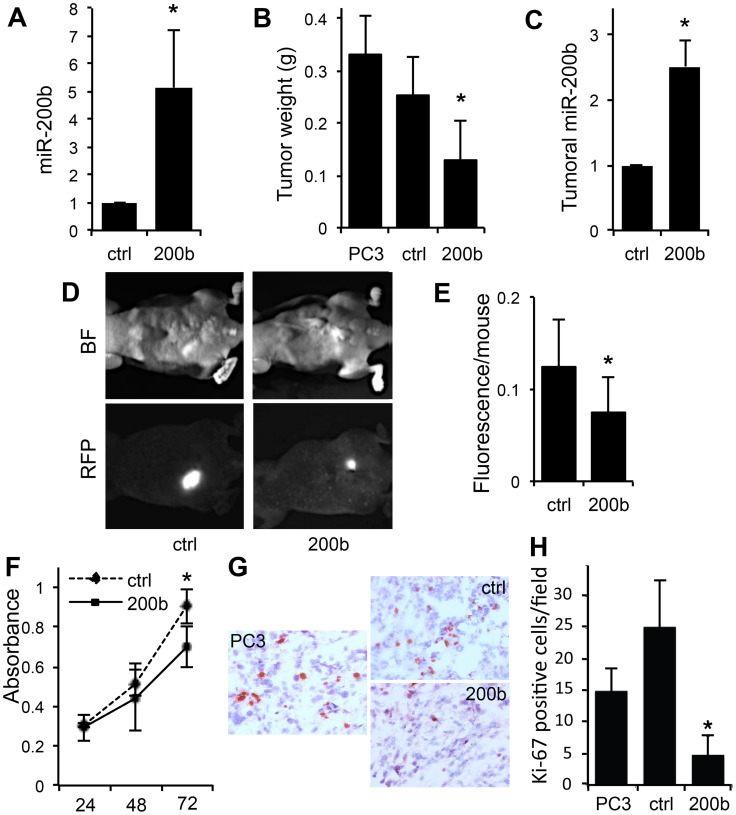miRNA regulate gene expression at post-transcriptional level and fine-tune the key biological processes, including cancer progression. Recently, researchers from the Feinberg School of Medicine at Northwestern University demonstrated the involvement of miR-200b in the metastatic spread of prostate cancer. Through miRNA microarray analysis conducted by LC Sciences, researchers identified miR-200b as a downstream target of androgen receptor and linked its expression to decreased tumorigenicity and metastatic capacity of the prostate cancer cells. Overexpression of miR-200b in PC-3 cells significantly inhibited their proliferation and the formation of subcutaneous tumors. Moreover, in an orthotopic model, miR-200b blocked spontaneous metastasis and angiogenesis by PC-3 cells. This decreased metastatic potential was determined to likely be due to the reversal of the epithelial-to-mesenchymal transition, as was evidenced by increased pan-epithelial marker E-cadherin and specific markers of prostate epithelium, cytokeratins 8 and 18. In contrast, researchers found that mesenchymal markers, fibronectin and vimentin, were significantly downregulated by miR-200b. Their results suggest an important role for miR-200b in prostate cancer progression and indicate its potential utility for prostate cancer therapy.
miR-200b is sufficient to decrease tumor growth
A) Forced expression of miR-200b in PC3 cells. PC3 cells were trasduced with a bicistronic lentiviral shuttle vector (pMIRNA1 pCDH-CMV-MCS-EF1-copRFP) encoding hsa-miR-200b and empty vector control (ctrl). Total RNA was isolated and miR- 200b expression measured using real-time RT-PCR. The values represent three independent experiments performed in triplicate. *, p≤0.01. (B) miR-200b reduced tumorigenesis by PC-3 cells. Parental PC3 cells, PC3 cells trasduced with miR control (ctrl) and miR-200b were subcutaneously injected into the rear hindquarters of athymic male mice (n = 5). Tumor weight at day 29 post-injection is shown. *, p≤0.05; **, p≤0.01. (C) The tumors maintained miR-200b expression. Relative miR-200b expression was measured by real-time RT-PCR in the tumors from panel (B). * p≤0.05. (D). miR 200b decreased tumor growth in an orthotopic model of prostate cancer. RFP-tagged PC3-ctrl and PC3-200b cells were implaned in the prostates of athymic male mice. The average fluorescence was measured 20 days post injection. (E) Fluorescence per animal was determined using whole body imaging, with Olympus OV100 system. *, p≤0.05. (F) Cell growth was measured by WST-1 assay. PC3-ctrl or PC3 miR-200b cells were seeded at 3000 cells per well in a 96-well plate. Absorbance was measured at indicated time points using a Biorad Model 680 microplate reader. The results represent the average of three independent experiments performed in triplicate. *, p≤0.05 by Student’s T-test. (G, H) Tumor sections were stained for Ki-67, to evaluate proliferation. Note a significant decrease in Ki-67–positive nuclei in the presence of miR-200b. *, p<0.001.
Related Service
miRNA Microarray Service – LC Sciences provides a microRNA (miRNA) expression profiling service using microarrays based on our in-house developed µParaflo® technology platform. We have standard arrays for all mature miRNAs of all species available in the latest version of the miRBase database (Release 21, July 2014). Our service is comprehensive and includes sample labeling, array hybridization, image data processing and in-depth data analysis. Two-three weeks after receiving your total RNA samples, we’ll send you both the raw and fully analyzed data. [Learn more…]
Reference
Williams LV, Veliceasa D, Vinokour E, Volpert OV. miR-200b Inhibits Prostate Cancer EMT, Growth and Metastasis. (2013) PLoS One 8(12):e83991. [article]

